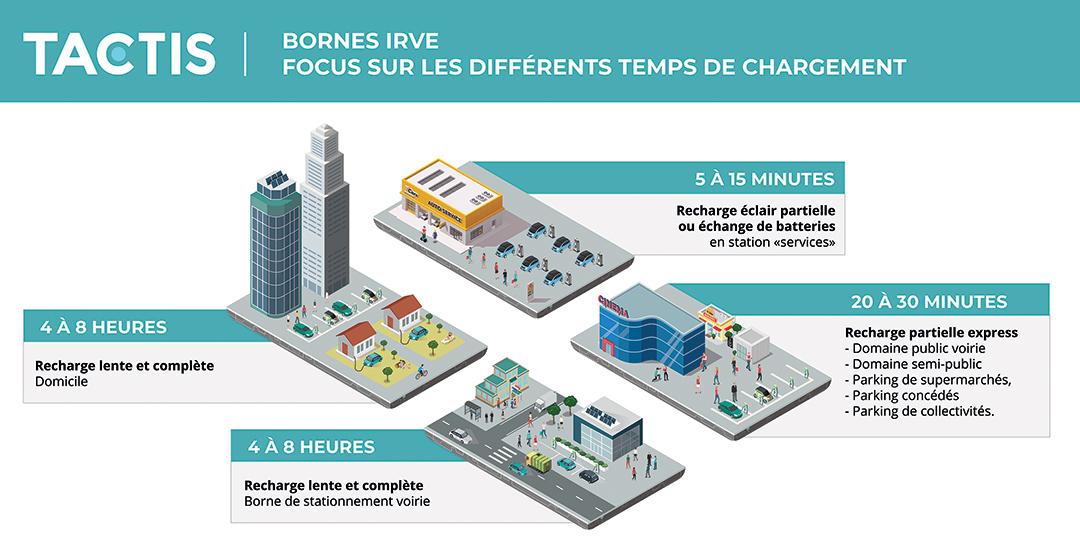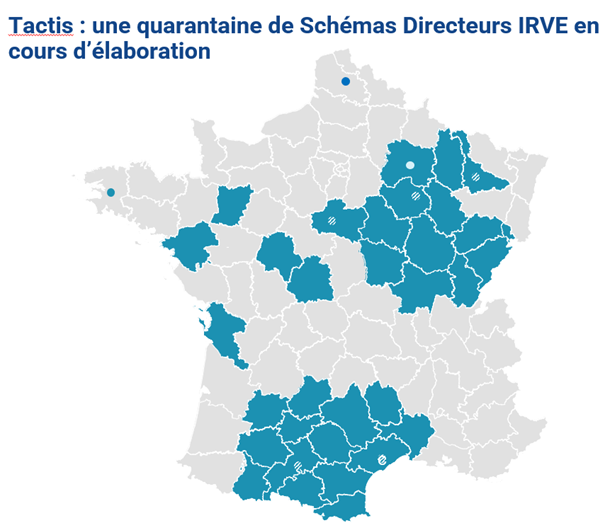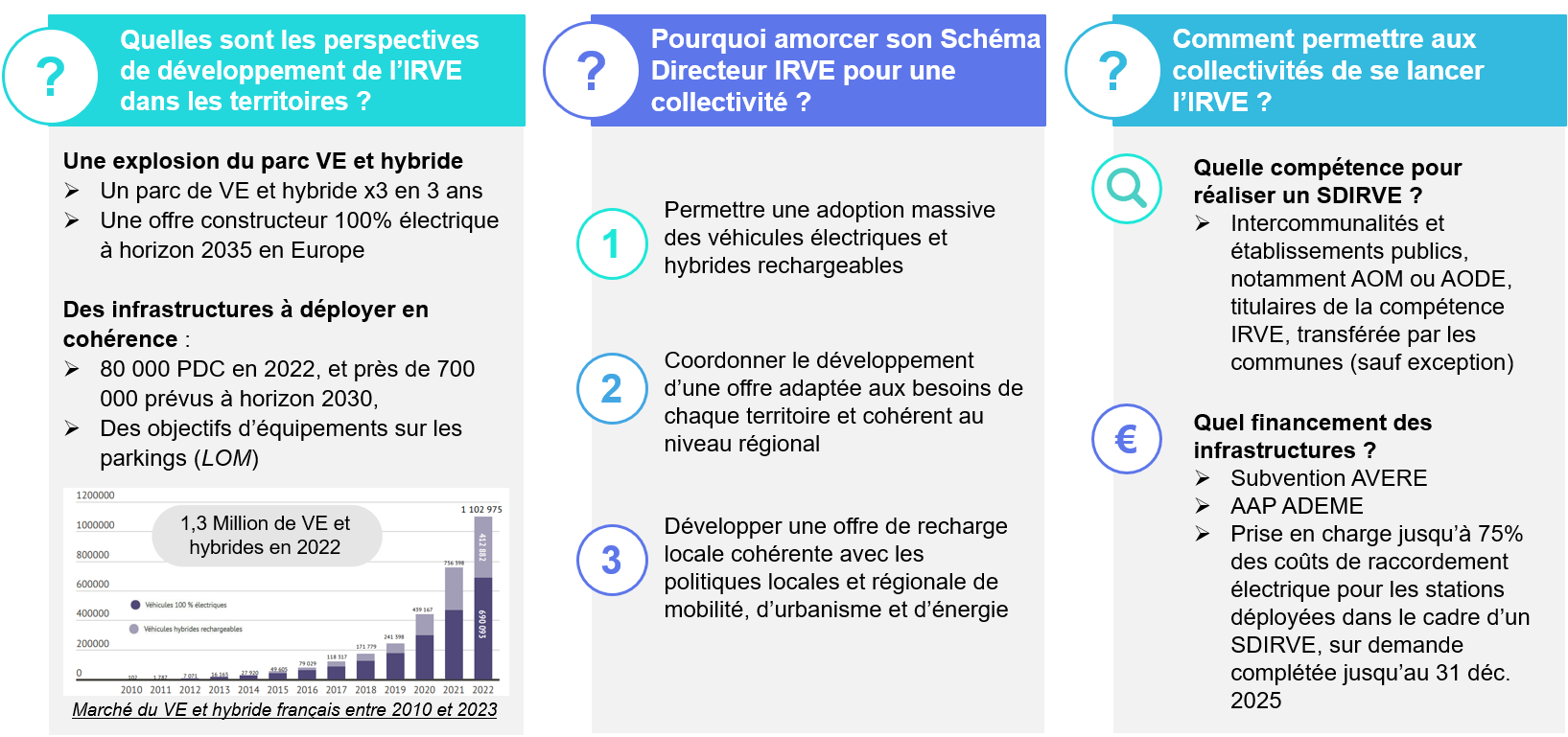LOM Act and SDIRVE
The Mobility Orientation Law (LOM) has given local authorities the option of drawing up these IRVE master plans. Decree 2021-565 and the order issued on 10 May 2021 in application of articles R.353-5-4, R.353-5-6 and R.353-5-9 of the Energy Code set out the procedures for implementing and validating them.
The main stages in the process are to carry out an analysis (of the existing situation, needs, vehicle fleet), draw up a development strategy (quantified objectives, timetable for implementation, resources required, etc.), introduce a tool for monitoring and evaluating the project, and publish certain data and results of the project in Opendata once the plan has been validated by the Prefect.
The SDIRVE can be set up by an entity with the authority to ‘create and maintain charging infrastructures for electric vehicles (IRVE)’ (paragraph 1 of article L.2224-37 of the CGCT) within its area of jurisdiction. Initially, this concerns municipalities, metropolises and urban communities, but these may transfer this responsibility (2nd paragraph of article L.2224-37 of the CGCT) to other entities such as:
- Public establishments for intercommunal cooperation (EPCI);
- Electricity distribution organising authorities (AODE), in particular energy syndicates;
- Mobility organising authorities (AOM).
It is also possible for a single SDIRVE to be set up jointly by several entities with IRVE competence, provided that their territories are adjacent (article R.353-5-7 of the Energy Code).
What are the objectives of an SDIRVE?
This document gives the local authority in charge of its implementation the role of orchestrator in the development of IRVEs open to the public in its territory, in order to facilitate the transition to electric mobility by responding to the following three major strategic areas:
- Coordinate the recharging service between the various public and private operators;
- Offer a public recharging service that is consistent with the various local policies in force or planned (mobility, protection of air quality and climate, urban planning and energy);
- A public recharging infrastructure adapted to the current and future needs of electric and hybrid vehicle users.

more concretely, an SDIRVE aims to:
- Define and anticipate public recharging needs:
o How many charge points (CPs) will be needed in 3 years? 5 years?
o What type of PdC should they be: slow, accelerated, fast, AC or DC?
o Where should charging points be installed: on roads? in public car parks? around shopping areas? in tourist areas? in business parks? on main roads? in residential areas?
o How should charge points be deployed: in a diffuse way, with a large number of stations each with a small number of PdCs spread throughout the country, or in a more condensed way, in a small number of stations each concentrating a large number of PdCs?
- Organise and supervise the deployment of charge points:
o Who is doing the roll-out and over what perimeter? Which players are involved and at what level in the value chain?
o What is the infrastructure contracting model: public-private partnership, public-private partnership, SEM, SPL, etc.?
o What is the roll-out schedule: when are each of the terminals due to be deployed? Which ones have priority?
o How to monitor the progress of rollouts: what indicators? what monitoring method?
How do you define your strategy and build your IRVE deployment plan?
In order to respond effectively to the above objectives and develop an optimal deployment strategy, a number of factors need to be carefully considered.
The first factor to take into account when devising the strategy to be adopted is the current and future state of recharging capacity on private property. At present, the vast majority of electric vehicle recharging takes place at home or at the workplace. (source: AVERE).
A good understanding of the development of charging facilities at users' homes and in businesses is therefore one of the key factors in determining the right size of public charging capacity required. The development of recharging services in the car parks of large retail outlets (such as supermarkets, shopping centres and cinemas) should also be taken into account in the development strategy for public charging points, as they are in direct competition with each other.
Similarly, the development strategies of the various private companies operating charging infrastructures accessible to the public (such as Tesla, EDF/Izivia, Ionity, etc.) will have a significant impact on the strategy to be adopted in the SDIRVE, the aim being to propose a public offering coordinated with the various private and public players in the sector and adapted to needs: planning to install charging points where others already exist or are going to be installed by other players is counterproductive.
A second fundamental element in the development of a relevant deployment strategy is knowledge of the various existing regional specificities. It is important to identify and characterise these particularities quantitatively, because mobility needs, and therefore electric vehicle charging infrastructure needs, vary from one region to another.
For example, the tourist nature of coastal regions in summer or mountainous regions in winter will have a significant impact on the use of public charging stations during these periods of the year in the regions concerned. Similarly, the rural or urban nature of the area will influence the travel habits of local residents, in terms of the preferred means of transport (private car, public transport, bicycle, etc.), the length of daily journeys or the frequency of travel: greater use of electric vehicles on certain roads, to the detriment of public transport, may lead to a greater need for charging points on these roads.
Knowledge of the specific characteristics of the area in question means that the different types of use of IRVEs can be quantified as accurately as possible: residential (individuals without a home charging solution, for example), professional (company fleets or taxis, for example) or occasional/inerant (tourists, for example).
Consultation is a third key to the success of the SDIRVE. The SDIRVE is first and foremost a collaborative document that should serve as a guideline for the development of public recharging infrastructure and unite all the players involved in electric mobility in the region.
It is therefore vital to include the various players in the sector, both public and private, from the outset (region, département, AOM, AODE, road managers, electricity distribution network managers, charging infrastructure developers and operators, EV/HV user associations, etc.) in order to gather their visions, expectations and objectives in this area.
What are the costs and subsidies associated with the deployment and operation of IRVEs?
The various costs involved in deployment and operation are:
- Investment costs, which include:
o Potential costs associated with upstream studies, project management and project assistance
o Equipment costs (charging stations)
o Civil engineering costs: foundations, trenches, infrastructure access, etc.
o The cost of installing and commissioning the charging stations
o Costs of connection to the electricity distribution network.
- Operating and maintenance costs, including :
o The cost of electricity (fixed charge per delivery point + variable charge based on the electricity consumed by the terminals)
o Infrastructure supervision and commercial operating costs (billing, user support, other services offered, etc.)
o Maintenance costs
Several forms of financial assistance exist to support investment in the deployment of these infrastructures. The two main types of aid are
- The ADVENIR programme.
The Advenir programme, supported by the French Ministry for the Ecological Transition and led by Avere-France, is playing a crucial role in accelerating the roll-out of charging infrastructure for electric and plug-in hybrid vehicles in France:
- At home: the Advenir programme offers a subsidy for the installation of electric vehicle charging points at home and in condominiums. This bonus can cover up to 50% of the installation costs, up to a certain amount.
- In the workplace: The scheme also offers a premium for the installation of charging points in the workplace.
This bonus is generally available to businesses, non-profit organisations and local authorities. - On the road: Finally, the Advenir programme supports the installation of charging points on roads and in public spaces.
These grants are designed to encourage the installation of charging points in densely populated and heavily used areas.
The Advenir programme is financed by the Energy Savings Certificates (CEE) scheme, a mechanism that obliges energy suppliers to make energy savings or finance energy-saving measures taken by other players.
With a budget of €320 million, Advenir aims to finance 175,000 new recharging points by 2025.
- The rebate: part of the cost of connection to the electricity distribution network is covered by the TURPE (Tarif d'Utilisation du Réseau Public d'Electricité).
Under article L.341-2 of the French Energy Code, up to 40% of the cost of connecting an electricity consumption site may be covered by the TURPE. A subsidised contribution of up to 75% of the costs of connecting charging infrastructures open to the public is applicable until the end of 2025, for any charging point that is part of a SDIRVE.
In addition to the ADVENIR programme and the rebate rate, which apply nationwide, local grants are also available, particularly in the Ile-de-France, Auvergne-Rhône-Alpes and Hauts-de-France regions. It is therefore essential to contact the local authorities in the regions, départements or communes concerned to identify and benefit from potential additional aid.
Tactis' support in structuring and implementing your SDIRVE?
With more than 30 years' experience in supporting public and private players as project management assistant (PMA) or business expert in regional planning, engineering and transformation, Tactis has developed expertise in network engineering, setting up public/private partnerships, managing and analysing regional data (GIS) and leading communities to successfully complete a co-construction project.
Tactis can support you throughout the implementation of your IRVE master plan.
We are working with more than forty project areas, with the ambition of designing public-private partnerships with a high impact on the acceleration of electro-mobility.

Our methodology is based on three main stages, so that we can best plan the first operational actions to implement this strategy.


Nicolas Potier
Contact Nicolas Potier
Do you have a question about IRVE master plans? Need to clear up any doubts about a future project? Send an email to Nicolas Potier, Tactis Associate Director.

